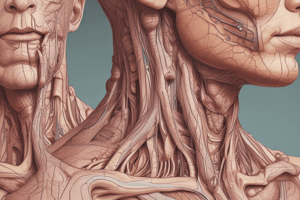Podcast
Questions and Answers
What is the largest organ in the body?
What is the largest organ in the body?
skin
Which of the following is NOT a function of the skin?
Which of the following is NOT a function of the skin?
- Regulates heat loss
- Protects from external agents
- Produces hormones (correct)
- Keeps water in the body
The epidermis is the deeper layer of the skin.
The epidermis is the deeper layer of the skin.
False (B)
How many principal layers does the skin have?
How many principal layers does the skin have?
Which layer of the epidermis contains living cells?
Which layer of the epidermis contains living cells?
The pigment responsible for skin color is called __________.
The pigment responsible for skin color is called __________.
Carotene is abundant in the skin of Europeans.
Carotene is abundant in the skin of Europeans.
What causes freckles?
What causes freckles?
What is the main function of the Stratum Corneum?
What is the main function of the Stratum Corneum?
Which type of cells in the stratum basale produce keratin?
Which type of cells in the stratum basale produce keratin?
Flashcards are hidden until you start studying
Study Notes
Integumentary System Overview
- Composed of skin (largest organ), sweat glands, sebaceous glands, hairs, and nails.
- Skin also referred to as integument, meaning "covering."
Functions of Skin
- Maintains hydration and prevents loss of essential molecules.
- Acts as a barrier to external elements, protecting against mechanical, chemical, and thermal damage.
- Insulates and cushions internal organs.
- Regulates body heat loss and acts as an excretory system via sweat.
- Manufactures essential immune-related proteins and stores vitamin D precursor.
- Contains sensory receptors for touch, pressure, temperature, and pain.
Principal Layers of Skin
- Epidermis: outer protective layer.
- Dermis: deeper supportive layer.
Epidermis Details
- Superficial layer composed of stratified squamous keratinized epithelium.
- Contains 4-5 layers, with the palms and soles featuring five due to increased friction.
Layers of Epidermis
- Stratum Basale: Base layer with keratinocytes (produce keratin), melanocytes (synthesize melanin), tactile cells (Merkel cells for touch), and Langerhans cells (immune response).
- Stratum Spinosum: Spiny appearance due to keratinocyte shape; limited mitosis occurs here.
- Stratum Granulosum: 3-4 flattened cell layers; presence of keratohyaline granules gives a granular appearance.
- Stratum Lucidum: Clear layer found in thick skin areas; contains eleidin.
- Stratum Corneum: Outermost layer, 25-30 layers of anucleated cells, continuously shed and provides protective cornified layer.
Skin Coloration
- Resulting from three pigments: melanin, carotene, and hemoglobin.
Melanin
- Brown-black pigment from melanocytes, protects against UV rays.
- Increased production due to sun exposure leads to tanning.
- Absence of tyrosinase in albinos results in no melanin production despite normal melanocyte numbers.
- Freckles: aggregates of melanin; vitiligo: localized loss of melanocytes.
Carotene
- Yellowish pigment located in the epidermis and dermis, prominent in certain ethnicities.
- Contributes to yellowish-tan skin tone.
Hemoglobin
- Oxygen-binding pigment in RBCs; contributes to skin's pinkish hue via oxygenated blood in the dermis.
Surface Patterns of Skin
- Congenital Patterns: Fingerprints or friction ridges, formed by elastic fibers, aid in gripping.
- Acquired Lines:
- Deep flexion creases on palms.
- Shallow flexion lines on knuckles.
- Wrinkles from repeated facial muscle contractions.
Studying That Suits You
Use AI to generate personalized quizzes and flashcards to suit your learning preferences.





